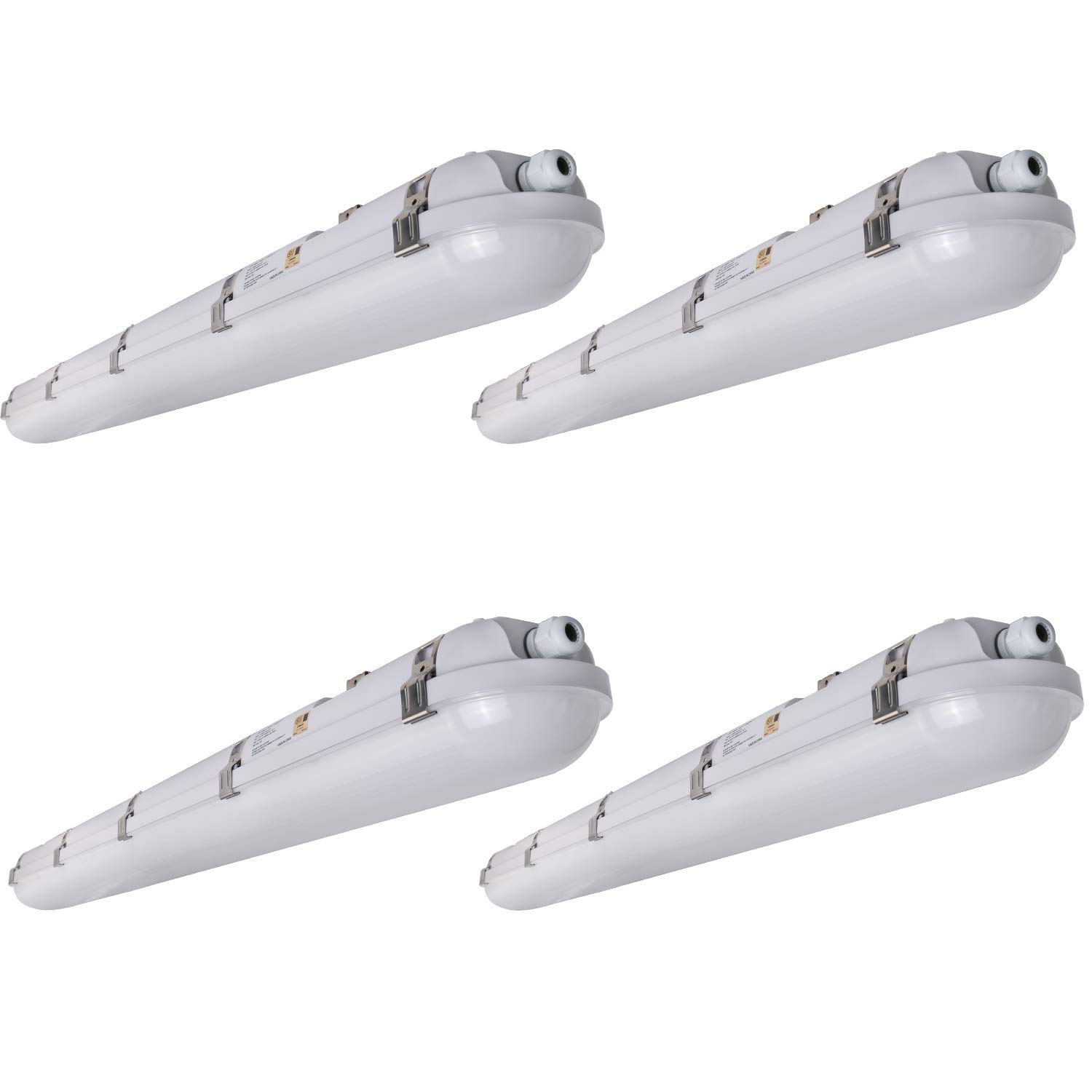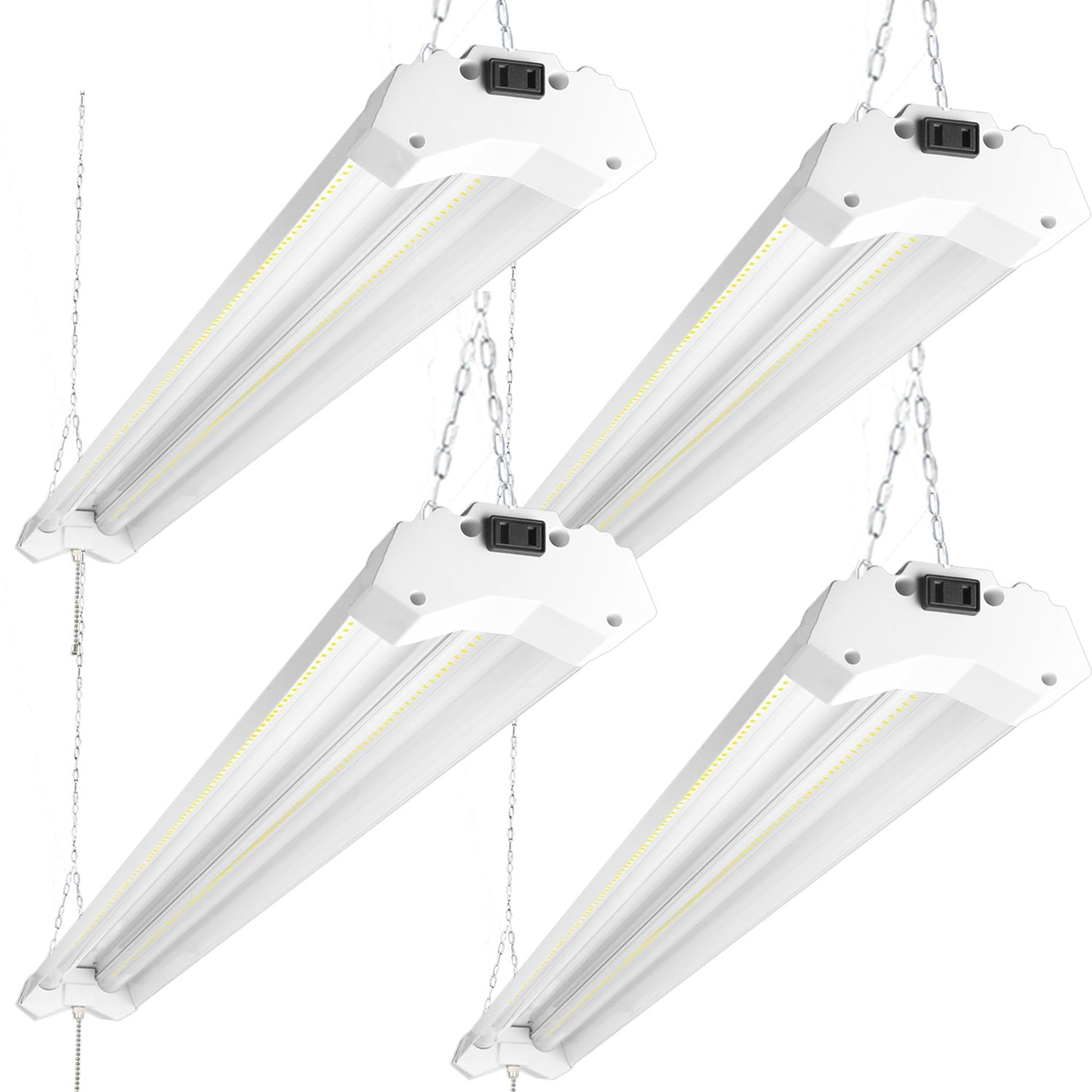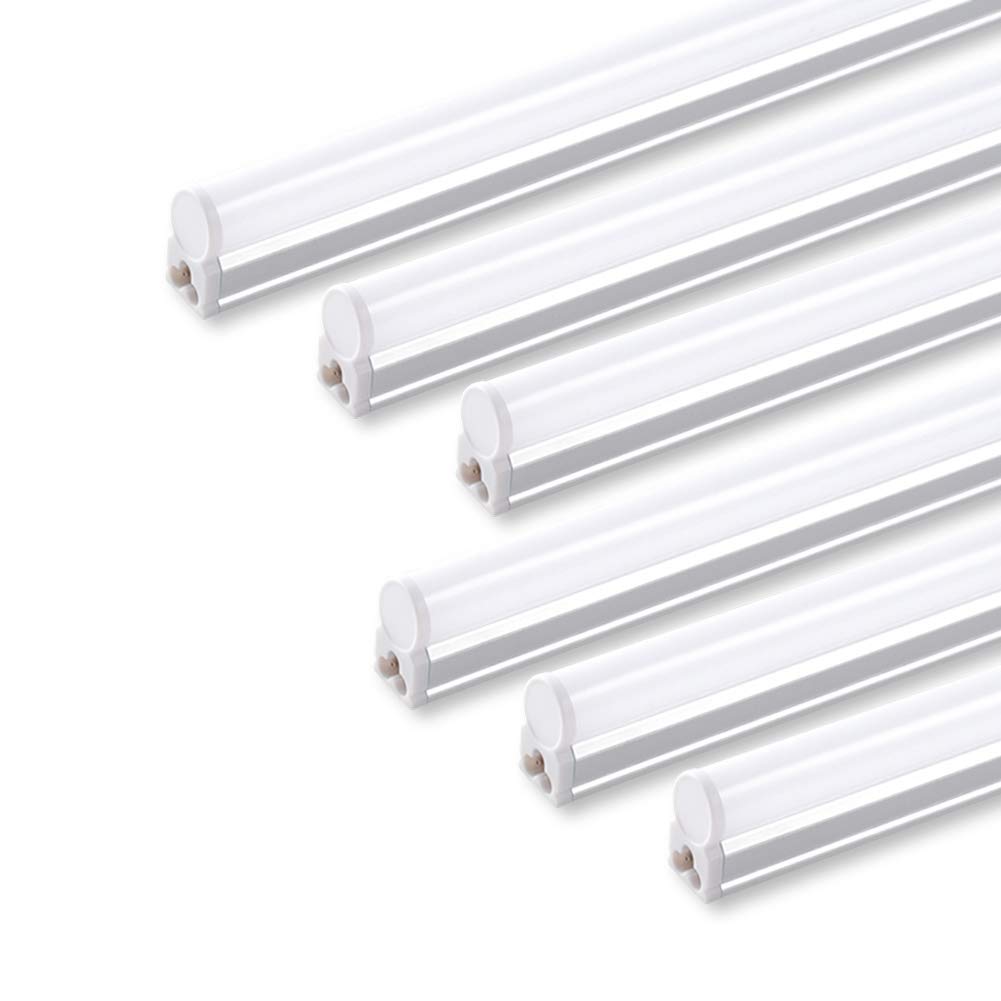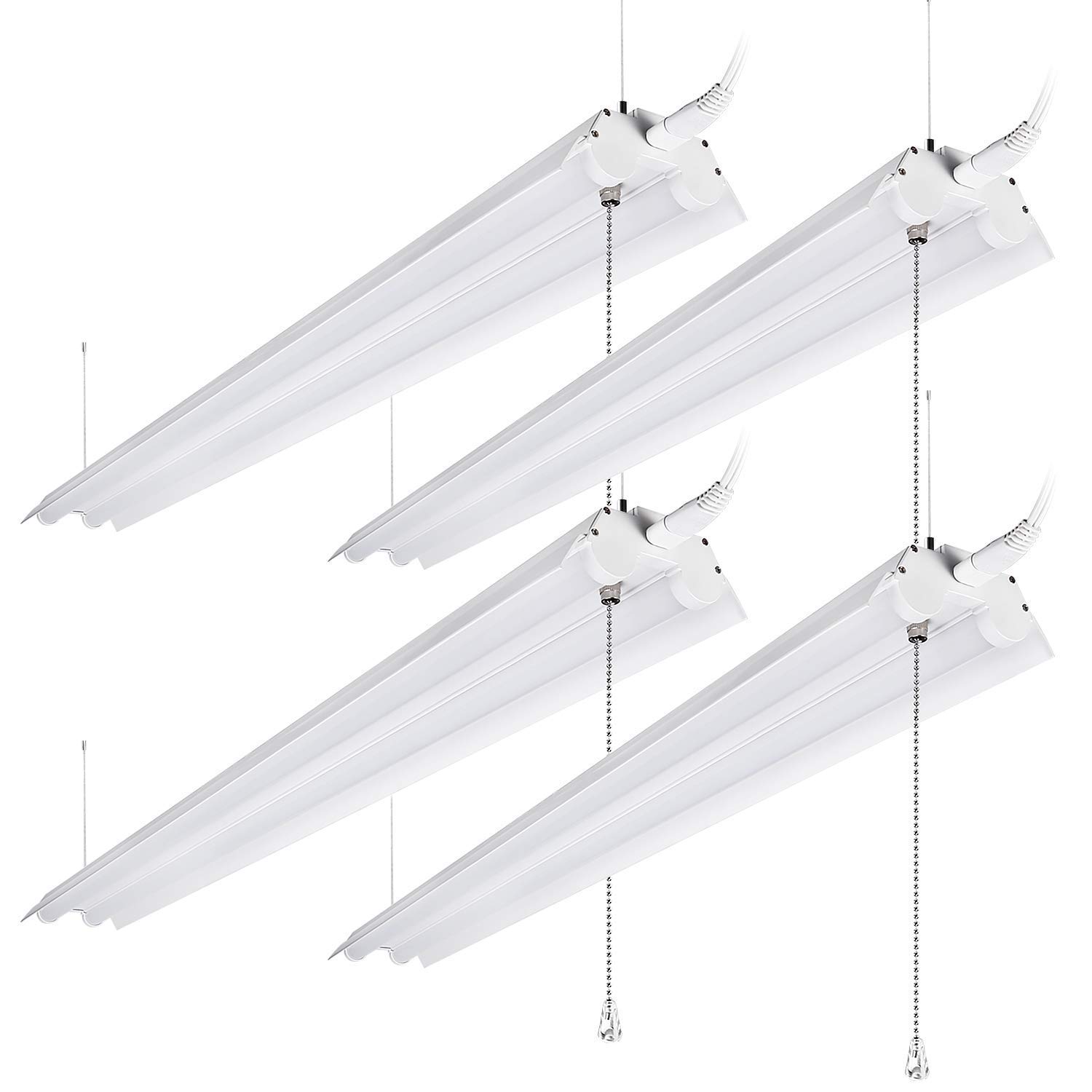 No matter whether you are accustomed to using your garage just as a place to keep your car at nighttime, as a warehouse for various basic items or as a workshop, you desperately need to have proper lighting. Most garages have no windows; and even if there is some kind of illumination there, it often appears to be insufficient, particularly if you’ve got used to working in your garage premises in the dead of the night or in the early morning.
No matter whether you are accustomed to using your garage just as a place to keep your car at nighttime, as a warehouse for various basic items or as a workshop, you desperately need to have proper lighting. Most garages have no windows; and even if there is some kind of illumination there, it often appears to be insufficient, particularly if you’ve got used to working in your garage premises in the dead of the night or in the early morning.
What’s more, your garage as a workshop is intended for multiple noisy and complex tasks that you can’t perform anywhere else. And it is a wide choice of LED lights available on today’s market that makes your daily tasks less tiresome and stressful as they let you work in more comfortable conditions. Read our guide on the basic features and technologies as well as pros and cons of each lighting option to ensure that all your needs are considered when you select the best one.





Top 5 LED Lights for Garage Workshop in 2019
Installing proper garage illumination will not just make your work space brighter but will also provide you with the necessary comfort. As a result, it will become easier to perform all your tasks and duties due to the increased visibility that you’ll get from the lights. And the best part is that it’s not too hard to find the best LED lights as long as you know what should be taken into consideration before making your final choice.
1 Hykolity Vapor — Brightest and Most Durable Option
This lighting option is majorly intended for industrial and commercial settings. It’s simply perfect for damp and wet environments as it is completely waterproof and can resist dust and dirt even in extreme conditions. What’s more, it’s ranked as one of the most durable options that can easily resist harsh wear and tear.
If you prefer some really bright lights, then this would be a perfect choice. This Hykolity light provides a very bright light, while its installation is easy and will not take too much time or effort if only you have a basic understanding of its assembly.
- Saves energy by providing 4400 Lumens
- Completely waterproof being designed for damp environments
- Has a long-term life span of 50,000 hours at a maximum
- Easy assembly.
- Connector is not fit for all types of conduit as it can only work with wiring
- A bit expensive
2 Hykolity Utility Shop — Best Energy-Saving Option with Good Warranty
These lights produce very bright light and are perfect for dark settings like garage, office, stairwell, or basement. They are also easy to install and allow saving much energy. What’s more, they are covered by all the necessary certificates, and this means you’ll be using completely safe, durable and efficient products that will last you for years.
In addition, if a warranty term is a matter of concern for you, you’ll be glad to learn that Hikolity offers a 5-year warranty on these lights. And this is not all – their price is more than affordable.
- Save much energy providing 50,000 hours of operation with no need for maintenance;
- Are of high quality and completely safe as they are covered by ETL and DLC certificates;
- Installation is easy;
- Can be installed in different settings;
- Long-term warranty of up to 5 years.
- Lamps cannot be removed. You’ll need to substitute the whole fixture when they fail.
3 Barrina — Long-Lasting and Super Bright Option
Although they are claimed to be made from durable aluminum and PC, the quality of materials is not perfect but they are still very long-lasting and are covered by a long-term warranty term with an ability to replace them easily and quickly.
- Superior brightness;
- Extendable design as they can link together 8 tube lights at a maximum;
- Easy assembly;
- Can be installed in a wide choice of settings;
- 3-year warranty;
- Long-term life span and low maintenance costs.
·
- Made from not very durable materials
4 Sunco Lighting — Top-Rated Fully Certified Commercial-Grade Lights
- Meet the strictest norms of quality and safety;
- Are suitable for creating an extendable design;
- 7-year warranty term;
- Easy to put up and do not require any maintenance.
- They have a relatively small life span offering only 10,000 hours of continuous use.
5Leonlite — Great Value for the Price
- You’ll use 60% less power;
- They have professional design being made from the best-quality materials;
- Provide super-bright 4000-Lumens lighting;
- Can be used in multiple settings.
- The installation process might take some of your time and effort.
Buyer’s Guide
 Today’s market of LED lights keeps showering customers with only good news. The prices have significantly decreased, and even if they still cost a bit more than regular bulbs, you’ll save loads of cash in the long run. You may also choose different light colors which was quite impossible with the older variations of LED lights. The benefits of these lights cannot be overestimated but customers may still get confused when selecting one. And it’s not a big surprise as LED lights can have different shapes and characteristics.
Today’s market of LED lights keeps showering customers with only good news. The prices have significantly decreased, and even if they still cost a bit more than regular bulbs, you’ll save loads of cash in the long run. You may also choose different light colors which was quite impossible with the older variations of LED lights. The benefits of these lights cannot be overestimated but customers may still get confused when selecting one. And it’s not a big surprise as LED lights can have different shapes and characteristics.
But selecting the most suitable bulb can be tricky as LEDs are in many ways different from incandescent lights. Before you go out shopping, there are many important things you need to keep in mind. To make your shopping experience easier, pay attention to the following considerations:
#1. Areas of Application
The first thing you are advised to do is to consider where you’ll be using your LEDs. Just because LED lights are still pretty costly, it is better to use them in spaces where you frequently need a bulb. It is not always preferable to install them in places where they will burn for years before they need to be replaced. This way, the cost will be repaid very soon and you’ll save loads of energy.
#2. Lumens vs. Watts
When choosing a suitable LED light, pay attention to how many Lumens the bulb can produce. Unlike a widespread belief, wattage does not indicate how bright the bulb is. Watts is an energy measurement, not an indicator of brightness. However, we are accustomed to buying regular bulbs according to their wattage. This is not the case with LED bulbs. Instead, you’ll need to take into consideration how bright the bulb is, and the brightness of LED bulbs is estimated a bit differently. It is commonly measured in Lumens. For example, to replace a 150-watt bulb, you’ll need a LED light worth 2600 Lumens.
#3. Color
Before making your final choice, make sure you select a preferable color. If you do not like the harsh white light of older LEDs, you’ll be happy to find out that there are many color options on today’s market. LED lights often come in warm yellow color or even bluish white so you’ll have multiple options to select from.
#4. Shape
The next thing you should do is to identify whether the light’s shape matches your fixture. LED lights can be of different (sometimes unusual) shapes. You may find spiral lights, globe-shaped ones and even those that look like candle flames. In our opinion, a small-sized cone-shaped light is ideal for most settings but choose the one that meets your taste and needs the most.
#5. Dimmer Compatibility
The last but not the least, you need to choose the best-matching bulb for dimmers. One more problem related to LED lights is that they are not always compatible with the dimmers in your garage or other settings. Some of them simply fail to work with a particular dimmer switch so be sure to select the correct one.
Benefits of LED Lights
From the consumer’s perspective, the key merits of using LED light bulbs are quite obvious: they are energy-saving, can last you for over 20 years or more and, in most cases, they produce better and brighter light. Above all, the prices have reduced considerably while the choice of designs can match the tastes of even the most demanding customers. Let’s sum up the major benefits and shortcomings of this type of illumination.
Energy-Saving
Modern-day LEDs are able to produce 135 Lumens/watts. This allows users to save up to 90% of energy when using these bulbs continuously. Besides, since LED lights are supposed to use cheaper power than incandescent bulbs, you’ll see an incredible decrease in costs and, therefore, won’t have to waste your money. Replacement and maintenance costs can also be saved provided that LEDs have greater life expectancy.
Long-Lasting
LED light bulbs have a long-term life span and can serve you right for 50,000 hours or even more if properly installed. They also require minimal maintenance and operating costs so you’ll just forget about them up until they will have to be replaced. As opposed to LED lights, usual bulbs have a lifespan of 1,500 hours at a maximum. Instead, a branded LED light will last more than 7 years of regular use before it burns out. This translates into considerable savings.
Durable
 Most of today’s LED lights are made from good-quality and sturdy materials that do not let any of their components break. This serves as a proof that they appear to be more cost-efficient and rugged in the long-term perspective. After all, they are sometimes called “Solid State Lighting” and not without a good reason.
Most of today’s LED lights are made from good-quality and sturdy materials that do not let any of their components break. This serves as a proof that they appear to be more cost-efficient and rugged in the long-term perspective. After all, they are sometimes called “Solid State Lighting” and not without a good reason.
No Warming Up
LED lights require no warm-up period as they light immediately after installation. This makes them a great alternative to ordinary bulbs.
Eco-Friendly
LED bulbs are made with the use of high-end technology and contain no hazardous components. Instead, they are made from safe materials that are not dangerous for the environment. If you are concerned about environmental protection, these lights will be an excellent choice.
Controllable
The level of brightness and color of LED light bulbs can be controlled as opposed to incandescent bulbs.
Safety
 Increased safety is probably the most important benefit that can be enjoyed by all users of LED lights. These lamps produce almost no warmth, and this means they are cooler to the touch, and you can leave them for hours without the risk of any accident. As such, LEDs reduce the safety risks considerably including injuries and fires among others.
Increased safety is probably the most important benefit that can be enjoyed by all users of LED lights. These lamps produce almost no warmth, and this means they are cooler to the touch, and you can leave them for hours without the risk of any accident. As such, LEDs reduce the safety risks considerably including injuries and fires among others.
Design
Beautiful design is something every LED light producer is trying to implement in their products. This innovation illuminates the surroundings with bright and color-rich light. Besides, LED light products look more natural and have a greater color rending so that everything around you will look vivid and vibrant. You may choose warmer or cooler lighting that would give you a different feeling each time you use these lights. Overall, the design of LED lights allows creating a contemporary look of your garage or other venue. The lights are specially designed to deliver an optimal level of light distribution without any annoying glare or hotspots. Instead, you’ll get pure glowing and beautiful light.
Drawbacks of LED Lights
LED lights have definitely become the latest and most admirable invention in the lighting segment. They are small but extremely powerful, long-lasting and cost-saving. LEDs can run differently as opposed to traditional bulbs. And this is what makes them more durable and sturdy than usual incandescent lights. The LED technology also has many other merits that all users might have heard of or read about. If to compare usual bulbs with LEDs, the latter prove to be the most energy-efficient solution of the recent years. And if you have not yet switched to LED bulbs, it’s high time you gained a first-hand experience right away.
However, it’s needless to say that each technology has not only positive sides but also a few negatives. Even though the drawbacks of LED lights are not very numerous, they may still be of much concern when you require choosing the most appropriate lights for your home. Here are several of them:
#1. Safety Hazards
Even though it is claimed by all LED light producers that their products are safe and eco-friendly, there is a concern that white and blue LED bulbs can exceed the safety limits and may be hazardous for eyes. It can be assumed that although technology has gone far ahead, LED lights are not yet sufficiently developed to provide a completely safe experience to users.
#2. Quality of Light
The majority of cool-white LED lights have a very different spectrum in contrast to the sun or incandescent bulbs. This may lead to a distorted perception of objects under cool-white LED lights. Nonetheless, it is also suggested that the color-rendering capacity of most advanced LED lights is much higher than that of fluorescent illumination.
#3. Dependence on Temperature
The performance of LED lights heavily relies on the temperature of the surrounding environment where they are running. In case LED lights are used in high ambient temperatures, it may lead to the overheating of the system and even provoke complete failure of the appliance. Therefore, to ensure the longevity of LED lights, it is advisable to maintain the appropriate temperature. This is particularly vital when LED lights are frequently used in medical or automotive settings where the instances of failure should be reduced to a minimum but the range of temperatures can still be really high.
#4. Risk of Pollution
Just because white LED lights emit greater portions of blue light than usual sources of lighting, they may provoke greater light pollution than some other types of lights. This is yet another matter of concern for those who are conscious about the environmental pollution.
#5. Too High Initial Price
LED lights are far more expensive than fluorescent lighting but in the long run this investment is supposed to pay off. However, it still requires considerable initial capital which may not be suitable for all users.
Despite all the above-mentioned drawbacks, LEDs are still a worthy investment, and their benefits definitely outweigh the drawbacks. Such merits as cost-efficiency and long life span alone can serve as a good reason to start using LED lighting for powering your home or garage.
Types of LED Lights
You may be long familiar with the kind of LED light that you have in your office or in various digital devices at home. But what about other types of LEDs? From what we know, there are multiple types and variations of these bulbs which can be installed in different settings and environments. Let’s have a look at them.
Miniature
This is perhaps the most widespread type of these bulbs. They are very small and often sold in only one color or shape. They can be used for mobile phones, calculators or remote control devices. Miniature lights are often very advanced and are sometimes used in automated industry segments.
High-Power
With the advancement of technology in the sphere of diodes, the High-Power LEDs have appeared on the market. These are often referred to as high-output lights as they generate a bit more Lumens than ordinary types. However, this particular type is sensitive to the risk of overheating so that it becomes important to connect it to some sort of heat-absorbing material to guarantee that it cools these lights down. This will not only increase their efficiency but also prevent these lights from burning out accidentally.
Industry-Specific
This type can be divided into different sub-categories such as the following ones:
Alphanumeric
These lights offer enough flexibility and allow saving much energy even though their popularity has decreased over the recent years.
Lighting
 These lights often come in a broad variety of shapes and sizes and are sometimes called LED bars, lamps or illuminators. The most common variation of such kind is the one that has an Edison design. It is very popular with users even though overheating remains a big problem for this type of LEDs.
These lights often come in a broad variety of shapes and sizes and are sometimes called LED bars, lamps or illuminators. The most common variation of such kind is the one that has an Edison design. It is very popular with users even though overheating remains a big problem for this type of LEDs.
Red Green Blue (RGB)
As suggested by the title, these lights consist of emitters of different colors like red, blue and green. They enable these three colors to be mixed in different numbers and produce different colors. The number of color combinations that you can get is almost endless.
Flashing
These LEDs look like ordinary bulbs on the outer side, but there is a circuit integrated into these lights that emits the relevant light at specific frequencies. This type of lights allows for immediate connection to the power supply and can be used in automobiles and other similar settings.
Questions and Answers
Not all types can. LED bulbs are often not removable but they are supposed to last a very long time. It is more probable that the AC/DC converter inside them stops working before these lights actually fail. Just because the price will eventually pay off, you may buy a whole new light with ease when the previous one burns out.
It largely depends on the brand but, basically, LEDs can be made from such materials as steel, polycarbonate cover or aluminum. Steel is more durable, and it is used in LED lights of better quality. But such lights may also be a bit more expensive.
LEDs are designed to last for many years. Some types have a life span of 10,000 hours while others can last for 50,000 hours at a minimum. In any case, you will hardly need a replacement for the next 7-10 years.
All LED lights are energy-efficient and designed to substitute all other types of bulbs like fluorescent, incandescent and others in your office, basement or home. They decrease the consumption of energy by 40% at a minimum. It mainly depends on the exact type of bulb you choose. Still, they do not require any maintenance so you’ll just forget about them until they finally burn out which is not going to happen for the next several years.
Not always. Not all LED lights are dimmable in the first place. Their driver needs to be designed in a way that will allow dimming. Besides, you need to buy the most suitable type of a dimmer. Most shops nowadays offer dimmers that are designed for LEDs in particular. However, if you buy a non-dimmable LED light and try to use dimmer controls, it may provoke the failure of a bulb, and it will not be covered by warranty.
No, LED lights contain no hazardous components, metals or chemical substances. They are by far the safest alternative to other types of lights so that if they stop working, you will not need to think of any particular disposal procedures.
Final Word
Finding a perfect LED light for your individual needs may seem like a difficult task but only at the first glance. Basically all you should do is know what you wish to get as a result. It is likely that in the nearest future, other LED light types will appear in this industry and the problems that they currently have will be fixed in the upcoming future. But even today, LED lights are a great alternative to other bulb options as they appear to be cost-efficient and energy-saving in the long-term perspective. They are likely to last you for years as long as you follow all recommendations on their use.
